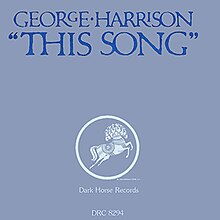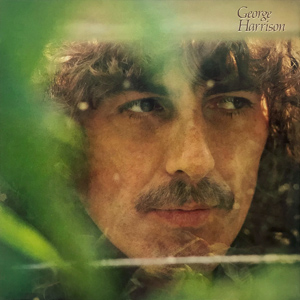
George Harrison is the eighth studio album by the English rock musician George Harrison, released in February 1979. It was written and recorded through much of 1978, a period of domestic contentment for Harrison, during which he married Olivia Arias and became a father for the first time, to son Dhani. Harrison wrote several of the songs in Hawaii, while the track "Faster" reflected his year away from music-making, when he and Arias attended many of the races in the 1977 Formula 1 World Championship. The album also includes the hit single "Blow Away" and "Not Guilty", a song that Harrison originally recorded with the Beatles in 1968.

Thirty Three & 1⁄3 is the seventh studio album by the English musician George Harrison, released in November 1976. It was Harrison's first album release on his Dark Horse record label, the worldwide distribution for which changed from A&M Records to Warner Bros. as a result of his late delivery of the album's master tapes. Among other misfortunes affecting its creation, Harrison suffered hepatitis midway through recording, and the copyright infringement suit regarding his 1970–71 hit song "My Sweet Lord" was decided in favour of the plaintiff, Bright Tunes Music. The album contains the US top 30 singles "This Song" – Harrison's satire on that lawsuit and the notion of plagiarism in pop music – and "Crackerbox Palace". Despite the problems associated with the album, many music critics recognised Thirty Three & 1⁄3 as a return to form for Harrison after his poorly received work during 1974–75, and considered it his strongest collection of songs since 1970's acclaimed All Things Must Pass.

"Love Comes to Everyone" is a song by English rock musician George Harrison from his 1979 album George Harrison. It is the opening track on the album and was also issued as the second single, after "Blow Away". The song reflects Harrison's contentment in his personal life as he was soon to become a father for the first time and married his second wife, Olivia Arias. Despite its commercial qualities, and contrary to some reviewers' predictions at the time of release, the song failed to become a hit.
"Don't Let Me Wait Too Long" is a song by English rock musician George Harrison, released on his 1973 album Living in the Material World. It was scheduled to be issued as a single in September that year, as the follow-up to "Give Me Love ", but the release was cancelled. Music critics have traditionally viewed "Don't Let Me Wait Too Long" as a highlight of the Material World album, praising its pop qualities and production, with some considering the song worthy of hit status.
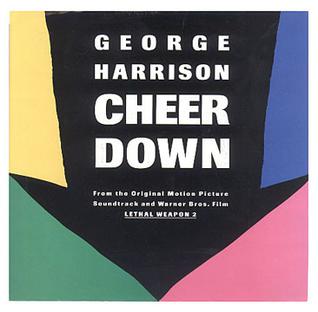
"Cheer Down" is a song by English musician George Harrison that was first released in 1989. The track was his contribution to the soundtrack of the film Lethal Weapon 2 and was also issued as a single. Harrison wrote the song with Tom Petty and co-produced the recording with Jeff Lynne.
"That's the Way It Goes" is a song by English musician George Harrison from his 1982 album Gone Troppo. Harrison wrote the song during a period when he had become uninterested in contemporary music and was enjoying success as a film producer with his company HandMade Films. Partly influenced by his extended holidays in Hawaii and Australia, the lyrics convey his dismay at the world's preoccupation with money and status, although, unlike several of Harrison's previous musical statements on the subject, he expresses resignation and acceptance.
"Awaiting on You All" is a song by English musician George Harrison, released on his 1970 triple album, All Things Must Pass. Along with the single "My Sweet Lord", it is among the more overtly religious compositions on All Things Must Pass, and the recording typifies co-producer Phil Spector's influence on the album, due to his liberal use of reverberation and other Wall of Sound production techniques. Harrison recorded the track in London backed by musicians such as Eric Clapton, Bobby Whitlock, Klaus Voormann, Jim Gordon and Jim Price – many of whom he had toured with, as Delaney & Bonnie and Friends, in December 1969, while still officially a member of the Beatles. Musically, the composition reflects Harrison's embracing of the gospel music genre, following his production of fellow Apple Records artists Billy Preston and Doris Troy.

"Deep Blue" is a song by English rock musician George Harrison that was released as the B-side to his 1971 charity single "Bangla Desh". Harrison wrote the song in 1970, midway through the recording sessions for All Things Must Pass, and recorded it in Los Angeles the following year while organising the Concert for Bangladesh. The composition was inspired by the deteriorating condition of his mother, Louise, before she succumbed to cancer in July 1970, and by Harrison's feelings of helplessness as he visited her in hospital in the north of England. Given the subject matter, "Deep Blue" also served to convey the suffering endured by the millions of refugees from war-torn Bangladesh in 1971, as sickness and disease became widespread among their makeshift camps in northern India.
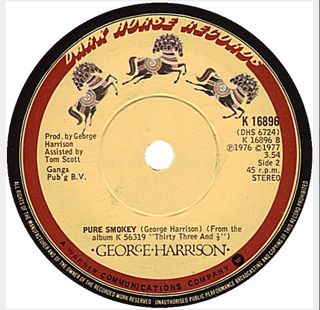
"Pure Smokey" is a song by English musician George Harrison, released in 1976 on his debut album for Dark Horse Records, Thirty Three & 1/3. The song was the second of Harrison's musical tributes to American soul singer Smokey Robinson, following "Ooh Baby " in 1975. Harrison frequently cited Robinson as one of his favourite vocalists and songwriters, and Robinson's group the Miracles had similarly influenced the Beatles during the 1960s. In the lyrics to "Pure Smokey", Harrison gives thanks for the gift of Robinson's music, while making a statement regarding the importance of expressing appreciation and gratitude, rather than forgetting to do so and later regretting it. The song title came from the name of Robinson's 1974 album Pure Smokey.

"Learning How to Love You" is a song by English musician George Harrison, released in 1976 as the closing track of his debut album on his Dark Horse record label, Thirty Three & 1/3. Harrison wrote the song for Herb Alpert, sometime singer and co-head of A&M Records, which at the time was the worldwide distributor for Dark Horse. Although the relationship with A&M soured due to Harrison's failure to deliver Thirty Three & 1/3 on schedule, resulting in litigation and a new distribution deal with Warner Bros. Records, Harrison still dedicated the song to Alpert in the album's liner notes.
"Here Comes the Moon" is a song by English rock musician George Harrison from his 1979 album George Harrison. Harrison wrote the song while on holiday on the Hawaiian island of Maui in February 1978. His inspiration for the composition was the appearance of the moon in the evening sky, just as the sun was setting. Although the lyrics focus on this natural occurrence rather than on the symbolism it suggests, in the manner of Harrison's Beatles track "Here Comes the Sun", the song is seen as a sequel to that similarly titled piece.
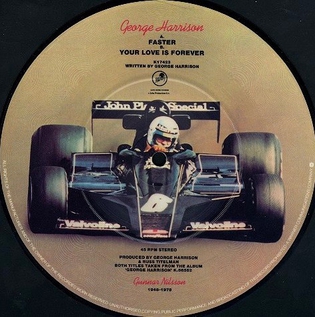
"Your Love Is Forever" is a song by English rock musician George Harrison from his 1979 album George Harrison. He wrote it as a guitar instrumental in an open tuning, before adding lyrics at the suggestion of his co-producer, Russ Titelman. The lyrics have an ambiguity typical of Harrison's work, in that the love he expresses is directed towards both a romantic partner and his God. In the United Kingdom, the song was also issued as the B-side of "Faster", on a charity single benefiting the cancer research project set up by the late Formula 1 driver Gunnar Nilsson.

"Soft Touch" is a song by English rock musician George Harrison from his 1979 album George Harrison. It was also issued as the B-side of the album's lead single, "Blow Away", in Britain and some other countries, while in markets such as North America, it was the B-side of the second single, "Love Comes to Everyone". Harrison wrote the song while in the Virgin Islands with his future wife, Olivia Arias, shortly before recording his 1976 album Thirty Three & ⅓. The song is a love song in which Harrison also conveys his wonder at the idyllic island setting.
"If You Believe" is a song by English musician George Harrison from his 1979 album George Harrison. Harrison began writing the song with Gary Wright on New Year's Day 1978 and finished the lyrics a month later while in Hawaii. The song appears as the final track on George Harrison. Its lyrics are a statement on the power of faith to bring about a desired outcome.

"Save the World" is a song by English rock musician George Harrison, released as the final track of his 1981 album Somewhere in England. It was also the B-side of "Teardrops", which was the second single off the album. An environmental protest song, "Save the World" was Harrison's first composition to directly address topical issues such as the nuclear arms race, rainforest and wildlife devastation, and the ecologically irresponsible practices of corporate concerns. Musically, the song partly recalls the style of the comedy troupe Monty Python.
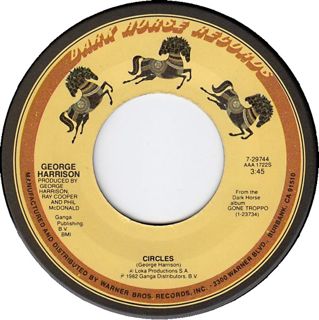
"Circles" is a song by the English rock musician George Harrison, released as the final track of his 1982 album Gone Troppo. Harrison wrote the song in India in 1968 while he and the Beatles were studying Transcendental Meditation with Maharishi Mahesh Yogi. The theme of the lyrics is reincarnation. The composition reflects the cyclical aspect of human existence as, according to Hindu doctrine, the soul continues to pass from one life to the next. Although the Beatles never formally recorded it, "Circles" was among the demos the group made at Harrison's Esher home, Kinfauns, in May 1968, while considering material for their double album The Beatles.
"I'll Still Love You" is a song written by English rock musician George Harrison and first released in 1976 by his former Beatles bandmate Ringo Starr. Produced by Arif Mardin, the track appeared on Starr's debut album for Atlantic Records and Polydor, Ringo's Rotogravure. The composition had a long recording history before then, having been written in 1970 as "Whenever", after which it was copyrighted with the title "When Every Song Is Sung".

"Apple Scruffs" is a song by English rock musician George Harrison from his 1970 triple album All Things Must Pass. He wrote it as a tribute to the die-hard Beatles fans known as Apple scruffs, who used to wait outside the Apple Corps building and other London locations for a glimpse of the band members. This tradition continued after the group's break-up in April 1970, as the scruffs were a regular presence outside the studios where Harrison recorded his album. The song was also issued on the album's second single, as the B-side to "What Is Life".

Songs by George Harrison is a book of song lyrics and commentary by English musician George Harrison, with illustrations by New Zealand artist Keith West. It was published in February 1988, in a limited run of 2500 copies, by Genesis Publications, and included an EP of rare or previously unreleased Harrison recordings. Intended as a luxury item, each copy was hand-bound and boxed, and available only by direct order through Genesis in England. The book contains the lyrics to 60 Harrison compositions, the themes of which West represents visually with watercolour paintings. Starting in 1985, Harrison and West worked on the project for two years, during which Harrison returned to music-making with his album Cloud Nine, after focusing on film production for much of the early 1980s. The book includes a foreword by his Cloud Nine co-producer, Jeff Lynne, and a written contribution from Elton John.
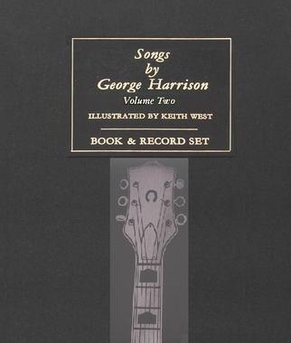
Songs by George Harrison 2 is a book of song lyrics and commentary by English musician George Harrison, with illustrations by Keith West and an accompanying EP of previously unreleased Harrison recordings. It was published in June 1992, in a limited run of 2500 copies, by Genesis Publications. As with Harrison and West's first volume, published in 1988, each copy was hand-bound and available only by direct order through Genesis in England.
